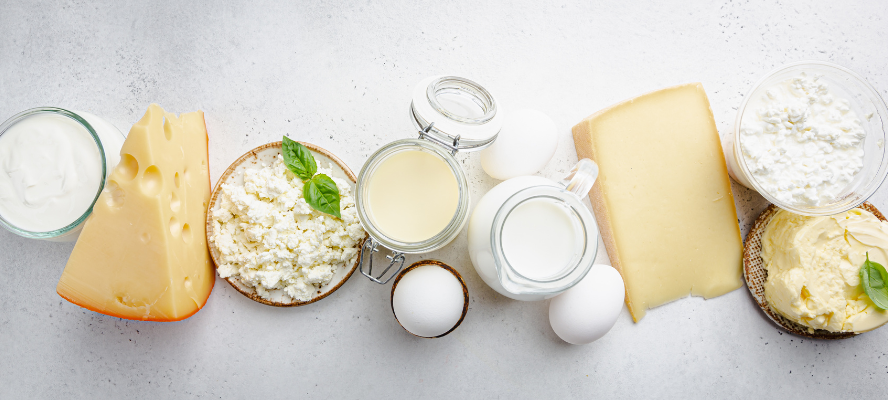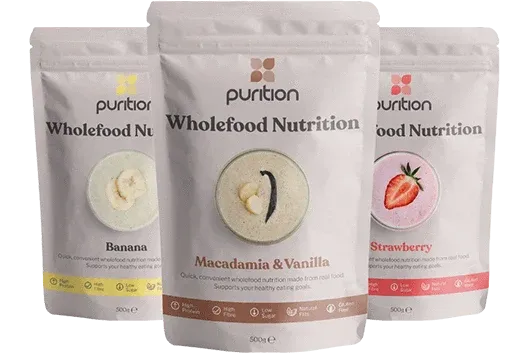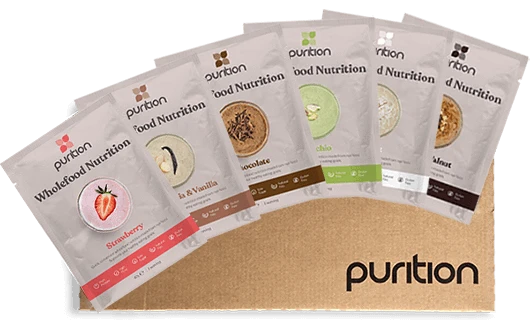This dairy-free diet guide is intended to help people with a diagnosed intolerance to dairy.
1–2 of every 10 people in the UK are intolerant to lactose, so dairy-free eating is more common than you might think. Plus, whether it’s down to skin flare-ups, going plant-based or a simple personal preference, many are choosing to ditch dairy for alternative reasons.
Whatever has brought you here, you’ll be pleased to hear that a dairy-free diet can be healthy, nutritious and delicious to boot. With a bit of dairy-free know-how, you can easily fill the pint-sized nutrient gap!
Here’s exactly how to eat dairy-free, including a dairy-free foods list, must-know tips to get started and all things dairy-free nutrition.
Understanding the Dairy-Free Diet
A dairy-free diet includes avoiding all or most dairy products including milk, butter, yoghurt, cheese, cream and ice cream. Unlike a vegan or plant-based diet, a dairy-free diet still includes other animal products, such as meat, fish and eggs.
If you’re on a very strict dairy-free diet or have a dairy allergy or intolerance to lactose, you might need to avoid all products containing milk, even in small or trace amounts.
Some products that do not contain milk as an intentional ingredient may have been made within a production facility that handles dairy, which can leave a small risk of cross-contamination.
Is a dairy-free diet healthy?
A dairy-free diet can be very healthy. While dairy products can be healthy and nutritious, they’re not essential.
The nutrients in dairy foods, such as protein, calcium and vitamin D, can be found in numerous other foods. However, if you’ve been used to a dairy-heavy diet, you will need to ensure that you fill in the gaps with the appropriate non-dairy foods to avoid nutritional deficiencies.
While many people do see positive effects after eliminating dairy from their diet, that doesn’t make dairy products inherently unhealthy. Dairy affects each person individually. Those who can tolerate dairy don’t need to cut it out; unless the motivation is ethical, of course. In moderation, minimally-processed dairy products are very nutritious.
Ultimately, with the exception of intolerances and allergies, deciding whether to eat dairy or ditch dairy is a personal choice. Thankfully, a healthy and balanced diet is possible either way.
For a deeper insight into dairy vs dairy-free, we’d recommend reading ‘Dairy: Is it good or bad for you?’ by Precision Nutrition.
The benefits to going dairy-free
Dairy-free diets can bring both health and environmental benefits:
Dairy-free diets can bring both health and environmental benefits:
- Gastrointestinal relief: Lactose intolerant or sensitive to dairy? Eliminating lactose from your diet will help to eliminate your gastrointestinal symptoms such as gas, bloating, diarrhoea and nausea.
- Clearer and calmer skin: If you’re struggling with acne or another inflammatory skin condition, you may find that your symptoms slowly decrease after cutting out dairy (Diet and Dermatology, 2014).
- Lower risk of some cancers: Observational studies indicate that a dairy-free diet can reduce the risk of prostate and ovarian cancer. However, it’s also important to consider that eating dairy is believed to have protective effects against colorectal and breast cancer.
- Decreased inflammation: Dairy products have been shown to cause inflammation, which in turn, may help to decrease the risk of chronic disease.
- Reduced environmental impact: Eliminating or reducing the amount of dairy in your diet can significantly reduce your impact on the environment. This is because dairy cows and their manure produce greenhouse gas emissions, which contribute to climate change (WWF).
Potential risks when going dairy-free
A well-planned dairy-free diet can be healthy. However, if you do not seek out the appropriate food sources to replace the nutrients found in dairy, you could be at risk of a nutritional deficiency.
Below, we cover 4 key nutrients found in dairy products and how you can make sure you’re still getting enough on a dairy-free diet.
Protein sources without dairy
Cow's milk, which was likely a huge part of your pre-dairy-free-diet, is a fantastic source of protein. A single glass contains all of the amino acids your body for cell repair and renewal. As you’ll be cutting out milk and products which contain milk entirely, you might need to increase the amount of non-dairy protein foods in your everyday diet.
The good news is that there are plenty of nutritious dairy-free protein sources to enjoy, including:
Dairy-free protein sources
|
Vegan protein sources
|
Aim to include a generous dairy-free protein source with every meal and you should have no problems filling in that pint-sized protein gap.
If you lead a particularly busy lifestyle and feel concerned about missing out on protein whilst switching to a dairy-free diet, try a dairy-free protein powder like Purition. Every serving contains 15–20g of dairy-free protein from seeds, nuts and European-grown plant protein for a helpful protein boost whilst adapting to a dairy-free diet.

Calcium on a dairy-free diet
Dairy products also contain high amounts of calcium, which:
- Forms teeth and bones
- Regulates nerve impulse transmissions
- Regulates muscle contractions
- Regulates hormone secretions
Source: The Essentials of Sport and Exercise Nutrition by Precision Nutrition.
A calcium deficiency can lead to low bone mineral density and a significantly increased risk of osteoporosis.
Therefore, if you switch to a dairy-free diet, it’s important to find a way to replace the lost calcium from the dairy products you were consuming. The good news? While dairy is an excellent source of calcium, it’s not the only source of calcium.
The recommended daily calcium intake for healthy adults in the UK is 700mg. Take a look at the following non-dairy calcium-rich foods list, to see how you can reach this level without consuming dairy.
| FOOD | PORTION SIZE | CALCIUM (mg) |
|---|---|---|
| Whitebait | Average portion – 80g | 688 |
| Tofu | Average portion – 100g | 100–500* |
| Tinned sardines | ½ tin – 60g | 300 |
| Fortified oat milk | ⅓ pint – 200ml | 240 |
| Fortified soy milk | ⅓ pint – 200ml | 178 |
| Fortified soy yoghurt | Small pot – 125g | 150 |
| Okra | Medium portion – 60g | 132 |
| Fortified rice milk | ⅓ pint – 200ml | 130 |
| Tahini | 1 teaspoon – 19g | 130 |
| Salmon | Medium portion – 100g | 91 |
| Kale | Medium portion – 60g | 90 |
| Tinned pilchards | Average portion – 110g | 75 |
| Sesame seeds | 1 tablespoon – 12g | 80 |
| Spinach (boiled) | 1 tablespoon – 40g | 64 |
| Chickpeas | 1 tablespoon – 35g | 56 |
| Broccoli | Medium portion – 85g | 34 |
| Almonds | Whole – 13g | 31 |
Source: NHS: Calcium for dairy-free
Iodine on a dairy-free diet
Cow’s milk is a key source of iodine, with a single glass providing almost half of the recommended daily intake. However, it’s not actually a naturally-occurring vitamin in dairy. It actually arises from the iodine supplements used in cattle feed, as well as iodine-containing disinfectants used to sterilise milking tools.
Iodine is used by the body make thyroid hormones, which help to keep your metabolism in check and your brain and bones healthy, amongst many other important functions.
The best dairy-free sources of iodine include eggs, seafood, seaweed, potatoes and strawberries.
Vitamin B12 on a dairy-free diet
Cows milk is also chockablock with vitamin B12, which:
- Protects the nervous system
- Makes DNA
- Makes red blood cells
If you’re aiming to cut out dairy but will still consume meat, fish and eggs, you’re unlikely to run into any problems in getting enough B12. However, if you choose to go vegan, gaining B12 can be tricky, as it’s mainly found in animal-derived foods.
The best vegan sources of vitamin B12 include nutritional yeast, marmite, spirulina, fortified dairy-free milk and yoghurt. You’ll need to make a point of including a selection of these foods in your daily diet and/or purchasing a good-quality B12 supplement.
What can you eat on a dairy-free diet?
The thought of cutting out your most-loved dairy products might seem difficult, but a dairy-free diet is much easier than you think. There are so many naturally dairy-free foods, alongside a fast-growing range of dairy-free alternatives. While it might take some getting used to, you’ll never feel deprived.

While it’d be impossible to list every single dairy and non-dairy food on the planet, here’s a list of the basic food items you can eat, and what you’ll need to avoid, on a dairy-free diet.
Dairy-free foods list dairy free foods list
- Fruits and vegetables
- Meat & poultry
- Fish & seafood
- Eggs
- Nuts & seeds
- Soy products, such as tofu and tempeh
- Beans & legumes
- Whole grains, such as quinoa and couscous
- Healthy fats, such as olive and coconut oil
- Herbs & spices
-
Dark chocolate (double check for milk)
- Dairy-free alternatives, such as nut milk, cream, cheese and yoghurt
- Purition Vegan
Foods to avoid
- Milk (try almond, oat or coconut)
- Condensed milk
- Cheese
- Butter & margarine
- Buttermilk
- Greek yoghurt (try coconut)
- Ice cream (try vegan alternatives)
- Sour cream
- Whipped cream
- Custard
- Milk & white chocolate (try dark)
- Creamers
- Whey protein
Unsure how to substitute milk? Take a look at our review of the best plant-based milks for smoothies and shakes to decide which alternative is best for you!

Foods to double-check
As milk is a key allergen, it must be emphasised within the ingredients list of prepacked food or drink by law. In the UK, you’ll find that most products emphasise any milk ingredients using a bold font.
When it comes to dairy-free foods, some products aren’t so black-and-white. Many unexpected processed foods contain small amounts of milk. You’ll need to make a habit of checking labels when you begin your dairy-free diet, especially if you’re lactose intolerant or have an allergy.
The following products are hit and miss when it comes to dairy-free foods, so remember to check the label before you purchase them:
|
|
Keep in mind that processed foods, such as breaded meat and seafood, sometimes contain dairy. Focus on unprocessed foods where possible and if you do opt for something processed, make sure to double-check labels.
Know your dairy-free labels
Not all lactose and dairy ingredients will fall under the simple name of ‘milk’ or ‘cheese’. If you’re strictly dairy-free or have a serious intolerance, getting clued up on labels is an essential part of learning how to go dairy-free.

You’ll want to keep a close eye out for the following ingredients, as they are all made from milk:
- Ghee
- Casein (curds), caseinates
- Calcium or sodium caseinate
- Hydrolysed casein
- Hydrolysed whey protein
- Lactoglobulin
- Lactoalbumin
- Lactose
- Whey, whey solids, hydrolysed whey
Is chocolate dairy-free?
Pure chocolate is dairy-free. It’s typically made with cocoa powder, sugar and cocoa butter (the fatty portion of the cacao bean), which are all naturally free from dairy.
However, the majority of manufacturers add milk, milk powder or butter oil to their chocolate bars. This is especially the case with milk and white chocolate, which generally isn’t dairy-free.
But you won’t have to have to go without chocolate on a dairy-free diet. Dark and plain chocolates are often free from dairy – just make sure to check the label, as some products do contain small amounts of milk.
There are a growing number of vegan and free-from chocolate bars available, which are completely free from milk and dairy. These may be the safest choice for anyone with a strict dairy allergy or intolerance as there is no risk of cross-contamination.

Dairy-free chocolate lover? You’ll love Purition Vegan in Chocolate, Chocolate & Hazelnut & Chocolate Orange. Try them all as part of your Discovery Box.
Are eggs dairy-free?
Eggs are not a dairy product. By definition, dairy products are made from or contain the milk of mammals. In contrast, eggs are laid by birds. Birds are not mammals and they do not produce milk.
Eggs are often mistakenly lumped into the dairy category because they’re stored beside each other in shops and supermarkets. However, you can still eat eggs on a dairy-free diet, as they’re simply not dairy.
The only exception to this would be if you wanted to go vegan, as you’d then avoid all animal and animal by-products, including eggs.
Dairy-free protein powder
Wondering what the deal is with protein powders on a dairy-free diet? Protein powders are traditionally made with whey, which is a by-product of the cheese-making process. This means whey (for the most part) contains lactose, making whey-based products, such as protein powders, unsuitable for anyone following a strict dairy-free diet.
But whether you’re a gym-goer or simply enjoy the convenience of protein powders, avoiding dairy doesn’t mean missing out. Purition Vegan is 100% plant-based and free from lactose. Made from 70% ground seeds, nuts and a complete plant-based protein blend, one glass provides 15–20g of protein and up to 38% of your calcium RDA, depending on the flavour.
If you have a serious lactose intolerance or milk allergy, you can feel safe in the knowledge that our dairy-free products are made and assembled down a meticulously managed production line within our purpose-built facility, to ensure there is no cross-contamination with milk-products.

Practical tips for transitioning to a Dairy-Free lifestyle
Transitioning to a dairy-free diet needn’t be daunting, complicated or intimidating. Here are some extra quick tips to help you make the move smoothly and seamlessly:
1. Plan your meals
If there’s one thing that’ll make going dairy-free difficult, it’s a lack of preparation. If dinner time rolls around and all you’ve got in the fridge is some veg and a block of cheese, it’ll be hard to create a filling and balanced dairy-free meal.
The solution? In the first few weeks or your dairy-free diet, make a point of planning your meals ahead of time. Pick your day, grab some cookbooks or use recipe websites and pick out some dairy-free recipes for the week ahead.
Make a shopping list of each and every ingredient you’ll need to see your meal plan through. This way, you can be sure that you’re fully stocked with everything you need for a healthy, nutritious and delicious week of dairy-free eating.
2. Choose whole foods
During your transition to dairy-free, you’ll be surprised at how many unsuspecting food products actually contain milk. From crisps and crackers to breaded meats and cold cuts, dairy is hidden in many processed and fast food products.
Wholefoods are much less likely to contain hidden dairy derivatives – and they just so happen to be much better for you, too! Cooking with majority whole food ingredients – such as lean meats, fish, legumes, fruits and vegetables – eliminates the worry of accidentally consuming dairy and makes for a highly nutritious diet to boot.
3. Be open minded - try everything!
Let's be clear – dairy-free milks taste different to cow's milk. Don't expect the taste to be the same – with time, your taste buds will adjust and stop expecting the taste of cow's milk.
There are so many different kinds of dairy-free milks and yoghurts. Oat, coconut, soy, almond, rice, cashew, hemp, hazelnut... we could go on and on!
Be open minded and give as many a try as you can – you're bound to find that you like some more than others.
4. Opt for vegan meals when dining out
Choosing foods or meals labelled 'vegan' when you're out and about is a great way to find some dairy-free gems that you might not otherwise take notice of. You can be sure these are dairy-free, without any fuss or anxiety.
And when you’re cooking at home, vegan and plant-based recipes can be a great source of inspiration. Search for vegan recipes online or purchase some vegan cookbooks. See which ones take your fancy, cook them up and, if you want to, add your choice of lean protein such as chicken or fish.
Even if vegan meals aren’t your thing, you’ll discover some fantastic dairy-free meal ideas by using this trick. Here's everything you need to know about vegan nutrition and recipes you can try.
How to go dairy-free
You’re now armed with all the information you’ll need to eat a healthy and balanced dairy-free diet.
The key to a healthy dairy-free diet is to ensure you’re filling the nutrient gaps that dairy previously filled. Thankfully, that’s easily achievable by consuming a wide range of wholefoods. Don’t forget to learn your dairy-free label lingo and give those labels a thorough read, especially if you’re avoiding dairy for medical reasons.
If you’re looking for an easy dairy-free breakfast or protein powder, don’t forget to check out Purition. Our dairy-free whole food blends can be blitzed into a quick shake, mixed into a crunchy yoghurt bowl or blended into nutrient-packed smoothie bowls.
Packed with protein, healthy fats and fibre and completely free from dairy, it might be just what you need for a smooth move to dairy-free!



